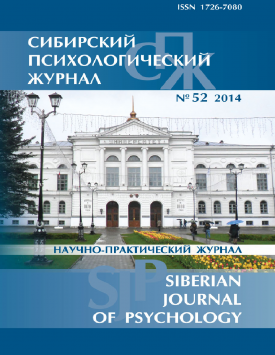Semantic evaluation of the situation of violation of psychological safety: cultural determinants
The article presents the results of the study of perception semantics by students in case of a disturbing psychological hazard. It also gives a short analysis of principal approaches to the psychological safety. Hypothetical assumption, verified in the process of research, made it possible to suppose that the semantic evaluation of the source of psychological hazard (a fraud, a manipulator) and his victim is greatly different and is caused by the affinity of the semantics of the self-esteem of those under test to one of the participants of a fraudulent situation. We also expected that the cultural identification might affect the evaluation of a fraud. In the course of the study the participants were evaluating the characters of a fraudulent situation. As a stimulating material we used, firstly, an original story by P. Chaldin about a trustful man, and the situation describing the way he was deceived, secondly, a modified variant of this test in accordance with the Russian realias. Fifty seven students were subject to tests. A modified method of the semantic differential by Ch. Osgud was used as the main method of the study. The study enabled us to describe the semantic structure of the evaluation of disturbing psychological safety. We also could find out stylistically the significant differences not only in the semantics of victims and manipulators but also in the semantics of a Russian and an American victims and a Russian and an American manipulators. The fraud is not always given more negative characteristics. When the evaluation was not conspicuous (metaphorical definitions without evaluating connotations) and when it actualized deep unconscious processes, the fraud was taken more positively than the victim. The study of the degree of affinity of the semantic self-esteem of the participants with their evaluation of the manipulator showed that the scales which imply an appeal to the conscious evaluation possess have a more differential force in case of self-esteem and that of a fraud. They are identified according to the criteria appealing to the unconscious semantic estimation. The obtained results show that the self-esteem of the students is close to their evaluation of a fraud and is different from the evaluation of a victim. The research demonstrated that the participants assess one and the same situation differently depending on the national and cultural identification of the participants both Russian and American. The Russian fraud is more cruel and cultivated. The results of the study showed that the semantic evaluation of the situation of the disturbing psychological hazard is determined by the following factors 1) identification of oneself with one of the participants of the situation, 2) national and cultural identification of a character. The students turned out to be more critical towards a Russian fraud than to an American one. It was elicited that one identifies himself with a victim on a conscious level, with a manipulator on an unconscious level.
Keywords
психологическая безопасность, жертва, мошенник, инкультурация, семантическая оценка, psychological safety and security, victim, fraud, acculturation, semantic evaluationAuthors
| Name | Organization | |
| Kyshtymova Irina М. | Irkutsk State University | info@creativity.ru |
| Basov Dmitry А. | Irkutsk Region College of Pedagogic Education | irbis-psy@yandex.ru |
References

Semantic evaluation of the situation of violation of psychological safety: cultural determinants | Sibirskiy Psikhologicheskiy Zhurnal – Siberian Journal of Psychology. 2014. № 52.
